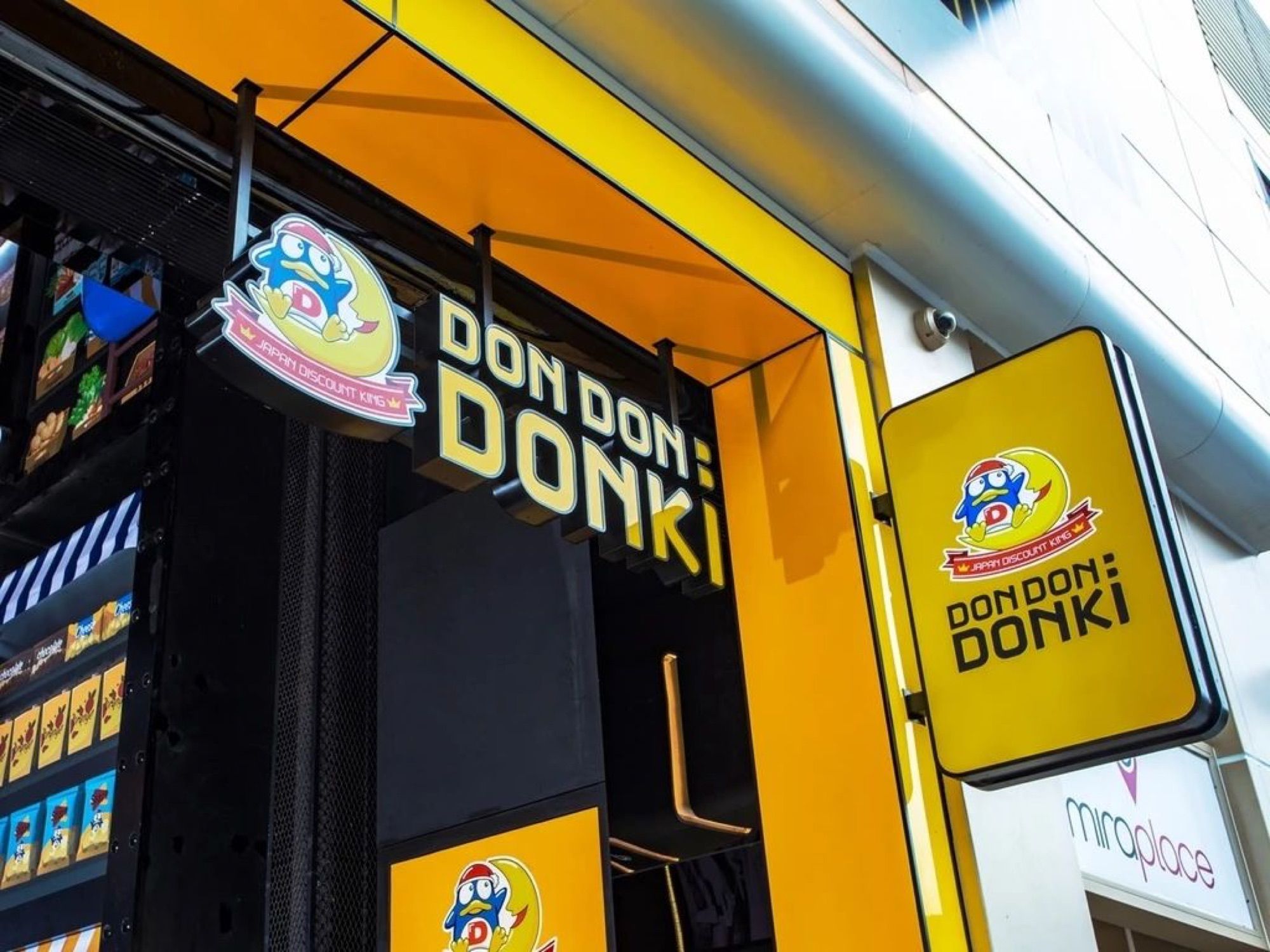In 2020, Don Quijote (Group Name: Pan-Pacific International Holdings), with 800 stores and a revenue of 1.6819 trillion yen (approximately 100 billion RMB), became the fourth-largest retail enterprise in Japan. Its distinct value lies in CVD+A, with CV standing for Convenience, D for Discount, and A for Amusement.

In A winning approach to discount retail in Japan – analysis of Don Quijote (Part 1),” we discussed how the success of the Don Quijote discount format was attributed to the abundance of residual supply resulting from the competitive environment of the 1980s in Japan. In A winning approach to discount retail in Japan – analysis of Don Quijote (Part 2),” we focused on analyzing the treasure hunt experience. We believe that it is one of the core values created by Don Quijote for consumers, the essence of which lies in designing precise displays, layouts, and interactions based on an accurate understanding of consumer psychology, allowing consumers to immerse themselves in the treasure hunt experience, exploring new products, surprising prices, and purchasing preferred items.
Behind the realization of this value is the business capability and business logic developed by Don Quijote’s founder, Ryuou Yasuda, through decades of exploration and experience. During an internal sharing session organized by GenBridge Capital, a core mindset emphasized by the original special advisor to Don Quijote is as follows:
“In the offline retail competition in the stock market, only by winning the direct battles between stores can one have the opportunity to achieve victory in positional warfare, gaining greater advantages in the supply chain, marketing, and logistics distribution.”
Building upon the previous content, this article provides an overview of Don Quijote’s business model, dissecting its operational characteristics and methods for consistent success. We will delve into three aspects of Don Quijote’s capabilities: 1. Audience targeting, 2. Source control, and 3. Store management. We believe that the dynamic integration of these three capabilities has contributed to the success of Don Quijote’s development.
Acquiring Premium Locations at Low Costs, Capturing Audiences through Nighttime Economy
The initial success of Don Quijote stems from its strategic positioning, avoiding direct competition with other soft discount and conventional retail channels. Don Quijote successfully tapped into its consumer base through the nighttime economy, where sales after 8 p.m. often contribute to 30% to 40% of total sales. Many of its stores operate 24 hours in various cities.
The late-night consumers primarily consist of young singles, couples wandering the streets at night, white-collar workers just off duty, and blue-collar workers in the service industry. Their consumption behavior resembles that of the protagonist in “Midnight Diner,” as they seek new stimuli throughout the city. Don Quijote’s founder, Ryuou Yasuda, once mentioned, “People get tired of karaoke and don’t want to go to izakayas after a certain point in the evening. At Don Quijote, they can spend the same amount of time and money, have a treasure hunt experience, and get inexpensive items.”
Since the first oil crisis in 1973, Japan underwent an economic structural transformation, witnessing a rise in the proportion of the tertiary sector. This led to an increase in white-collar and service industry blue-collar workers in urban areas. These workers often finish work late, and head off to after-work drinking. When they finally decide to head home, only convenience stores are still open. According to a 1994 study on discount stores, Don Quijote’s late-night operations attracted a highly overlapping consumer base compared to convenience stores.

Dense Display at Don Quixote
This overlap in audience provided an advantage to Don Quijote’s discount model. As mentioned in “Analyzing Don Quijote (Part I),” the rapid turnover of products in convenience stores supplied a constant stream of residual goods, which became the export for Don Quijote. The “discounted prices” offered by Don Quijote were relative to those in convenience stores. When these consumers saw familiar products being sold at exceptionally low prices at Don Quijote, they were pleasantly surprised. Despite not being the most price-sensitive group, unlike bargain-hunting mothers, Don Quijote became their preferred channel.
Don Quijote’s store model and consumer characteristics indirectly mitigated the pain points of soft discounts in terms of an unstable supply chain. Ryuou Yasuda mentioned in a 2003 interview:
“The weakness of soft discounts lies in the unstable supply. Consumers may not find what they want when they visit. However, by capturing nighttime economy consumers, whose demands are not repetitive purchases but rather seeking stimulation and freshness through a treasure hunt experience, we create a space where every visit offers a different sense of freshness. Gradually, consumers see us as a channel for discovering new things, recognizing that items available this time might not be there next time.”
For instance, in the cosmetics section, Don Quijote categorizes products into National Brands, Overseas Brands (Korean and Western brands), Emerging Niche Brands, and Individual Items. The purchasing manager checks @cosme rankings and ratings (similar to Japan’s Red) online daily, selecting rapidly trending products and lowering the selling price through a profit margin mix. Don Quijote’s ability to quickly respond to beauty trends enables consumers to see the latest and hottest products with each visit.
Don Quijote has maximized opportunities brought by economic downturns in its site selection strategy, expanding stores with lower Capex. During economic downturns, enterprises in large store formats such as comprehensive supermarkets, electronic malls, and clothing brands find it challenging to maintain the profitability of each individual store and are forced to cut losses by closing down stores. However, lease contracts often extend up to ten years, leading to penalties for early termination. Moreover, vacated spaces are difficult for other formats to utilize, causing losses for real estate management companies. Don Quijote seizes these vacated spaces, entering with minimal store opening costs. Although these spaces may be aged, strategic layouts and intensive displays obscure any signs of wear and tear from the consumers. Approximately 70% of Don Quijote’s total stores, around 560 outlets, follow this “takeover” model. In principle, the monthly rent for stores in non-prime locations is approximately equal to the store’s daily sales.
Deep Supplier Integration and Opportunistic Purchasing Strategy
Don Quijote originated from a surplus wholesale business called “JUST.” While the treasure hunt experience and the nighttime economy serve as its weapons, surplus supply was its early shield. In 1978, founder Ryuou Yasuda, 29 at that time, opened a small discount store called “Thief Market” in Tokyo. During the second oil crisis in Japan, many businesses and factories faced bankruptcy, and to ensure cash flow, they needed to quickly liquidate their inventory. Yasuda seized this opportunity to purchase surplus goods at extremely low prices and cleverly utilized the nighttime economy to sell various goods to consumers. Over time, he conceived the idea of becoming a surplus wholesale distributor, selling “Thief Market” to others in 1980, and establishing the surplus wholesale company “JUST.”
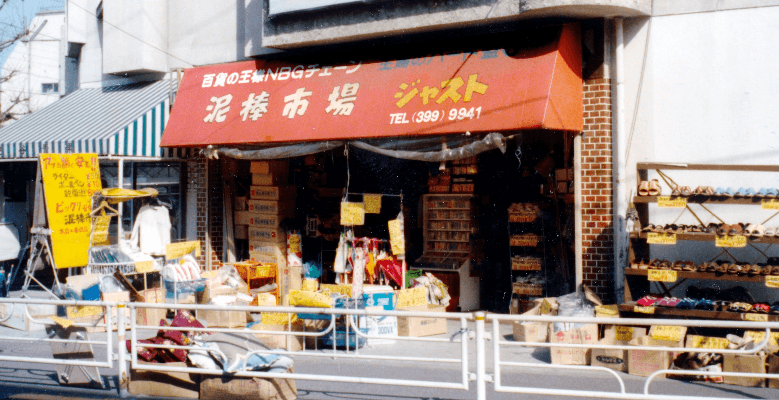
Thief Market Established in 1978
According to his account in a book, when founding “JUST,” there were thousands of soft discount stores in Japan. Despite the low entry barrier for the soft discount format, attracting a considerable number of entrepreneurs, Yasuda discovered over ten years in the surplus wholesale business that none of these stores achieved scalability. He emphasized that during good economic times, these store owners made a little money and then spent it on luxury items and real estate, unable to resist the temptation to focus on their business. In 1989, seeing no formidable players emerging in the market, Yasuda returned to the retail side and opened the first store in Fuchu City, a suburb of Tokyo. Initially, he attempted a franchise model, opening around 13 stores, but later found that no one understood his treasure hunt experience operational mindset. Consequently, he decided to switch to a direct-operated model.
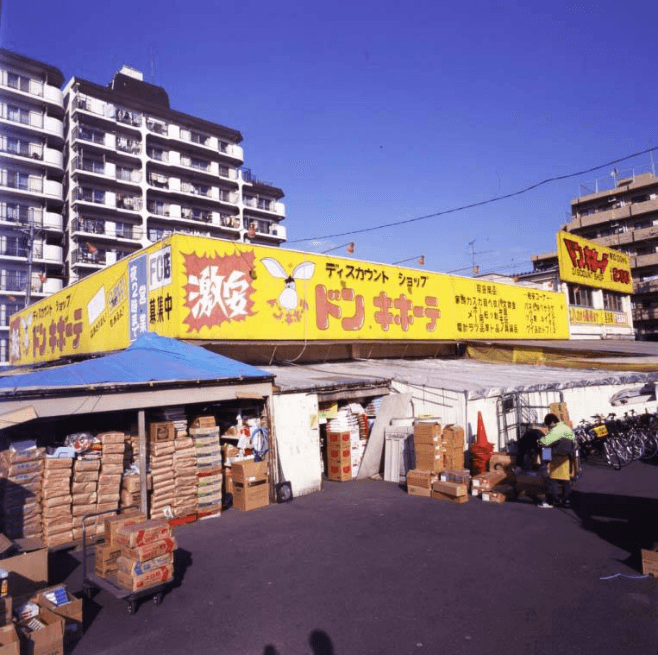
Don Quixote Store in Fuchu City in 1989
Leveraging its supply chain advantages, Don Quijote maintained a product mix of 60% regular goods and 40% discounted goods in its early stages. Regular goods were priced 10% to 30% cheaper than other channels such as convenience stores and Ito-Yokado. For 100 to 150 high-repurchase-rate SKUs with high consumer price sensitivity, Don Quijote set the prices at the lowest in the region to gain consumer trust. The prices of discounted goods could be as low as 50% or even less than the regular prices due to “opportunistic purchasing.” Most purchasing decisions were made by store staff, promoting integrated purchasing and sales responsibility. The unique characteristics of Don Quijote’s decentralized store management system will be discussed separately in the section on store management.
For Don Quijote, the 40% of discounted goods procured through “opportunistic purchasing” serve as a source of profit. They have a slogan, “High price for cheap stock, low price for expensive ones.” These inexpensive goods are often surplus or leftover items from manufacturers or wholesalers during product packaging iterations, challenging to circulate through normal channels. Contrary to popular belief, non-food items constitute an essential source of gross profit for the channel. Currently, only 15% of Don Quijote’s gross profit comes from food items, while sports and outdoor goods yield a gross profit as high as 35%.
Upstream suppliers for Don Quijote are referred to as “Rack Jobbers” – suppliers offering shelf service. These suppliers not only provide goods but also assist with product display and replenishment. If a new store opens, they help set up shelves and merchandise, ensuring their products get better shelf positions. According to a former high-ranking Don Quijote executive, many shelf suppliers have been loyal to the collaboration, transforming from small enterprises with only two or three people into hundreds of people, thanks to their longstanding cooperation with Don Quijote. Additionally, in the early days, Don Quijote negotiated a payment term of only 2 to 3 days in cash settlement with suppliers. Consequently, suppliers recommend good products to Don Quijote first. Being one step ahead in obtaining good and scarce supplies became one of its early critical competitive advantages.
The method of purchasing surplus goods from upstream suppliers and manufacturers may differ based on the company’s development stage. In the early stages, store staff had a portion of the budget, allowing them to communicate directly with suppliers or brand owners for purchases. However, as the company reached the mid-term development phase, this approach was a waste of time and energy at the store level and also risks corruption. Consequently, it transitioned to a centrally supervised procurement system: each store accessed the internal procurement platform app to obtain the latest product information and then competed for sources independently. According to a former Don Quijote executive, this app is similar to LINE, allowing stores to communicate with suppliers anytime, with a plethora of product information available every day, and on a first-come, first-served basis. However, large quantities of surplus goods from major brands are directly purchased by the headquarters’ merchandise department, coordinating with the brands.
Due to the unique nature of opportunistic purchasing, Don Quijote adopted the “Consignment Inventory” model in its warehousing and logistics operations starting in 2000. In this context, “consignment” refers to Don Quijote entrusting suppliers with inventory management and distribution. The ownership of goods remains with the suppliers until they reach the stores, and the wholesalers share the costs of inventory and distribution. Before this model, suppliers primarily distributed goods to each store based on their own plans, with the staff responsible for purchasing the product and handling the receiving process. However, as the number of suppliers exceeded 2,000, store personnel could no longer coordinate every delivery. Since 2000 (when revenue was approximately 5.5 billion RMB), Don Quijote gradually introduced this model into 50% of its products, then gradually increasing the percentage every year. Through this, Don Quijote achieved zero inventory risk, reduced stockout rates, and shortened the time and effort required for replenishment. For non-cooperative suppliers, high logistics sponsorship fees, up to 1.5% of the product value, were imposed, enforcing compliance.
As Don Quijote continued to grow, a trend of insufficient supply emerged in the “opportunistic purchasing” category, constituting 40% of the product composition. Transforming limited supplies of surplus goods into unlimited supplies posed the most significant challenge for the soft discount format in the long term. In response, in 2008, Don Quijote launched its PB “Passionate Prices.” Currently, Don Quijote’s PB accounts for approximately 10% of total revenue, contributing 16% to the overall gross profit. 2008 was also the year of the subprime mortgage crisis, and Japan had surplus production capacity, providing Don Quijote with an excellent opportunity to reach upstream supply.
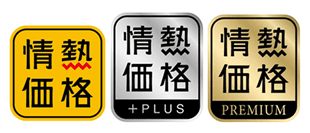
Three different PB brands corresponding to three different price ranges
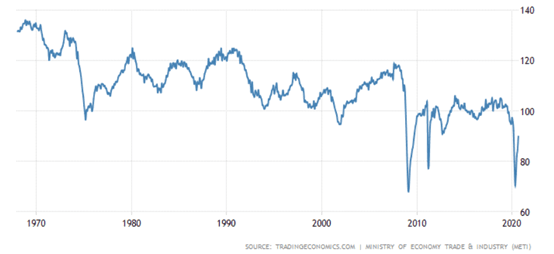
Capacity utilization rate in Japan from 1968 to 2020. Daiei introduced the first PB of Japan during the first oil crisis in 1973. Don Quijote’s PB, cleverly introduced during the economic crisis in 2008, took advantage of surplus production capacity.
Empowered Yet Centralized: Strengthening Single-Store Competition
Within a business district’s radius, the outcome of individual store confrontations determines the fate of the entire channel. The advantages in demographics and supply chain control mentioned above ultimately enhance Don Quijote’s single-store combat capability in a saturated competitive environment. As for the “internal strength” to establish sustainable competitive advantages in corporate culture, Don Quijote’s DNA exhibits a more aggressive nature compared to other Japanese retail channels. The key feature lies in simultaneously utilizing decentralized management while employing a centralized supervision and incentive model.
At the store level, Don Quijote grants purchasing authority. The quantity of goods purchased by the store side accounts for over 30% of the total store products. This authority is not only given to store managers and category managers but even part-time employees have the right to make purchases. Especially in the early stages, when Don Quijote had not yet entered the phase of rapidly expansion, store autonomy was greater, allowing for a higher percentage of goods to be purchased. To maintain a basic level for each store, the proportion of goods distributed by the headquarters is now around 70%. Opportunistic purchasing is mainly carried out through Don Quijote’s internal app.
Pricing authority and the right to change display layouts also fall under the responsibility of the store, akin to a unified procurement process on the store side. The core purpose is to hold individuals accountable for business performance, clearly reward and punish, and use flexible capabilities to counter surrounding competitors, fully implementing the purpose of the treasure-hunting experience – guiding consumers to buy specific popular items through price and quality comparisons. A member of Don Quijote’s founding team emphasized (this was mentioned in Part Ⅱ and is reiterated for emphasis):
“The conventional retail approach is that if a shelf sells 5,000 RMB per month with one slot, a shelf with 50 SKUs may sell around 250,000 RMB per month. However, we see this differently. We strive to achieve sales of up to 500,000 RMB for one slot, using product comparisons, labels, and slogans to highlight individual items. Using the same logic, we aim to create more best-selling products on the same shelf. By placing multiple SKUs together for price comparisons, Don Quixote sells around a single popular product. When National Brand canned coffee is sold for 5 RMB/can, they will find a white-label canned coffee to sell for 2 RMB/can or 3 RMB/2 cans, guiding consumers to buy the low-priced, high-margin white-label.”
The authority of stores in pricing, purchasing, and changing display layouts is aimed at enhancing the competitive capabilities of individual stores. Find ways to sell at a high price for products not available to competitors, and actively sell at a low price for products available to competitors, adjusting prices and selections in real time. If a store successfully forces surrounding competing stores to close through competition, the headquarters will reward the store employees with a gold medal.
Behind Don Quijote’s decentralized store authority lies the characteristic of centralized control. Firstly, unlike traditional Japanese corporate culture, Don Quijote does not favor the establishment of strong relationships between employees. The company lacks a retirement pension system, unions, mutual aid organizations, and social group activities (such as sports teams). The company strictly penalizes corruption, encourages internal supervision, and rewards informers.
In personnel reviews, both at the headquarters and the store level, the criteria are based on gross profit margin, sales volume, and turnover rate. In principle, these figures are only allowed to exceed the previous year’s, and the wages will be reduced if the performance this year sink. Personnel reviews are conducted every six months. Every review results in a 20% salary reduction, a 30% salary increase, and a 20% staff turnover annually. Departing employees are referred to as “metabolism officers.” Income assessments for regional managers (responsible for 3-5 stores) and large regional managers (responsible for the entire region) follow the same criteria. To boost their own performance, regional managers often visit poorly performing or inexperienced stores to train them on product selection, seasonal theme planning, intensive display, and zoning planning.
Summary: Don Quixote and Don Quixote
The channel’s name is derived from the Spanish novel “Don Quixote.” The protagonist, Don Quixote, embodies multiple contradictions, indulging in fantasy, detached from reality, yet steadfast in his beliefs and an advocate for freedom. Don Quijote discount stores share striking similarities. They appear to offer cheap prices, but in reality, they are not the cheapest. They claim decentralized store management, but there is strong central supervision. They provide a treasure-hunting experience but guide consumers to buy specific products. The store’s displays, music, and layout immerse consumers in a hallucinatory time and space, momentarily forgetting the outside world. They refer to their competitors as Disneyland.
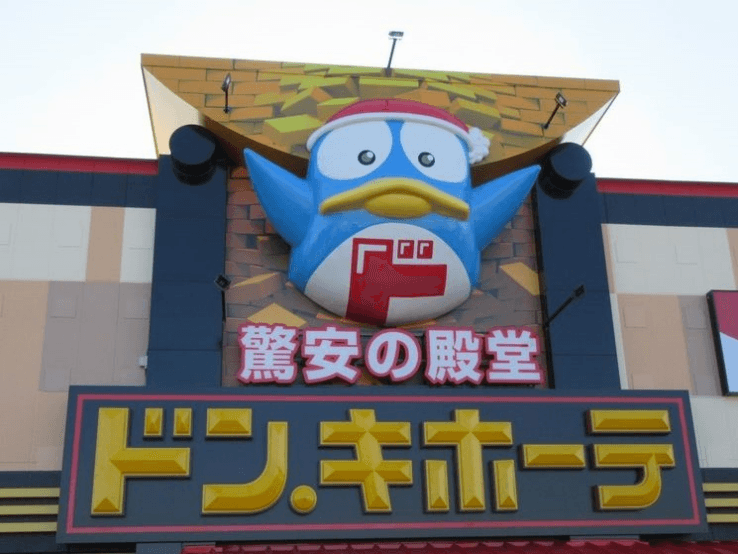
Don Quijote Stores with an Entrance Like an Amusement Park
Don Quijote seized upon structural changes brought about by shortened product lifecycles, the rise of convenience store channels, and the explosion in the number of new products within Japan’s saturated competition. Through night economies and treasure-hunting experiences, they tapped into a unique consumer group. Behind this lies a deep connection with surplus goods suppliers, decentralizing procurement authority to stores, allowing each store to obtain the “lowest price” and the “optimal product selection” in various business districts. This achieved the company’s unique value: CVD+A, where CV stands for convenience, D for discount, and A for Amusement. Rather than describing Don Quijote as a discount store today, it’s more accurate to say it is a successful department store with clever sales methods.

In the 2013 autobiography of the founder, Takao Yasuda, he repeatedly emphasized his intention to enter the Chinese mainland market. However, after entering Hong Kong and Singapore, Don Quijote has yet to open its first store in mainland China.
Today’s Chinese market is complex and unique in terms of the supply chain, channels, and brands. Sales of high-margin non-food categories, Don Quijote’s specialty, have been largely replaced by online e-commerce in China. The so-called “treasure-hunting experience” has also been squeezed by emerging and diverse new trends, such as live-streaming e-commerce and interest-based e-commerce. Will there be a Chinese version of Don Quijote? What will its business model look like? Let us wait and see.
References
- Yasuda, Takao. “Passionate Entrepreneur – Revolutionary Retail Management Theory of Don Quijote’s Founder” (2013) [Japanese]
- Economic and Industrial Research Institute, Japan. “What Formula Allows Laughter in the Face of Recession? Growth and Innovation through ‘Non-Uniform Business Formats’? Entrepreneurial Spirit and Wisdom of Don Quijote” (2003) [Japanese]
- Japan International Business Publishing. “Gekiryu” May 2017, December 2017, December 2019 [Japanese]
- Suzuki, Mayumi. “Discount Store Heisei Distribution Revolution: Men Challenging Price Destruction” (1994) [Japanese]
- Minamigoshima, Yukazu. “Urban Theory of Single Space” (2018) [Japanese]
Internal Documents:
- “GCIA Initiates Consumer Alliance: Insights from a Special Advisor to Don Quijote.”
- “Surfing the Crest of Economic Cycles, Innovation, and Romance in Discount Stores: Comparative Study of Japanese and American Discount Stores and Benchmarking in Japan.”
Interviews:
- Mr. W, former Special Advisor to the founder of Don Quijote
- Mr. Y, former Head of Human Resources at Don Quijote
- Mr. A, former senior executive of the Seibu Group’s retail division, FamilyMart convenience stores


